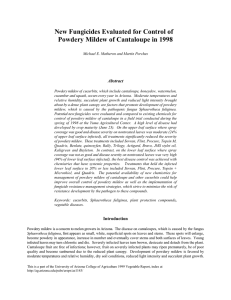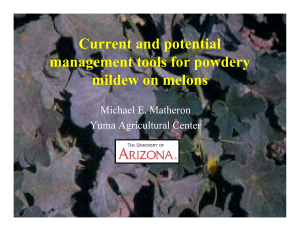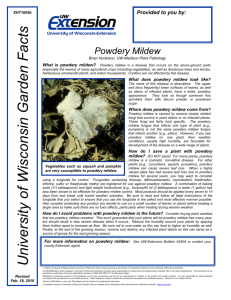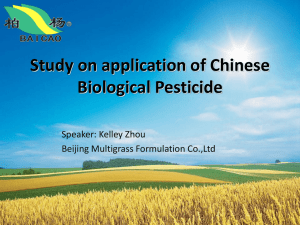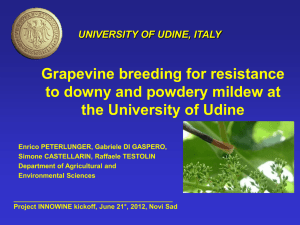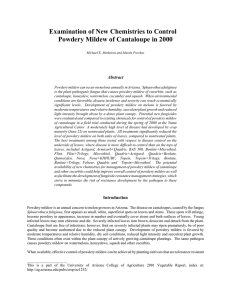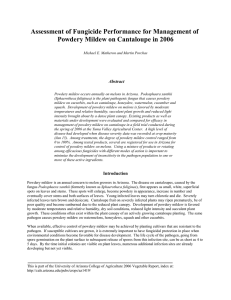Examination of New Chemistries to Control Abstract
advertisement
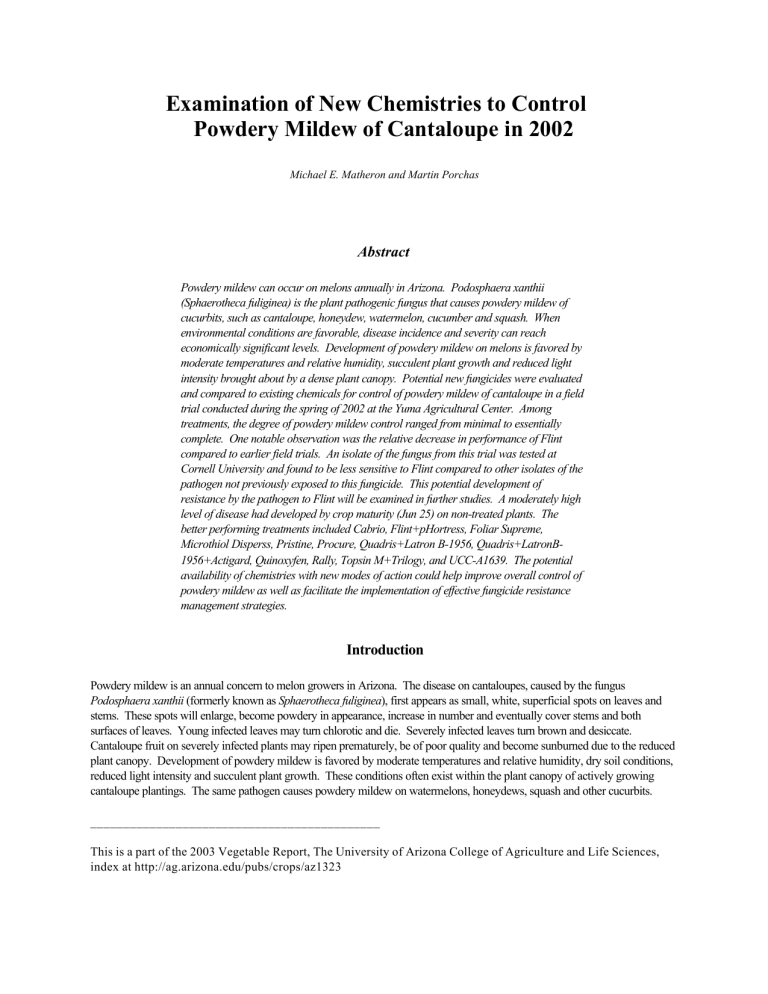
Examination of New Chemistries to Control Powdery Mildew of Cantaloupe in 2002 Michael E. Matheron and Martin Porchas Abstract Powdery mildew can occur on melons annually in Arizona. Podosphaera xanthii (Sphaerotheca fuliginea) is the plant pathogenic fungus that causes powdery mildew of cucurbits, such as cantaloupe, honeydew, watermelon, cucumber and squash. When environmental conditions are favorable, disease incidence and severity can reach economically significant levels. Development of powdery mildew on melons is favored by moderate temperatures and relative humidity, succulent plant growth and reduced light intensity brought about by a dense plant canopy. Potential new fungicides were evaluated and compared to existing chemicals for control of powdery mildew of cantaloupe in a field trial conducted during the spring of 2002 at the Yuma Agricultural Center. Among treatments, the degree of powdery mildew control ranged from minimal to essentially complete. One notable observation was the relative decrease in performance of Flint compared to earlier field trials. An isolate of the fungus from this trial was tested at Cornell University and found to be less sensitive to Flint compared to other isolates of the pathogen not previously exposed to this fungicide. This potential development of resistance by the pathogen to Flint will be examined in further studies. A moderately high level of disease had developed by crop maturity (Jun 25) on non-treated plants. The better performing treatments included Cabrio, Flint+pHortress, Foliar Supreme, Microthiol Disperss, Pristine, Procure, Quadris+Latron B-1956, Quadris+LatronB1956+Actigard, Quinoxyfen, Rally, Topsin M+Trilogy, and UCC-A1639. The potential availability of chemistries with new modes of action could help improve overall control of powdery mildew as well as facilitate the implementation of effective fungicide resistance management strategies. Introduction Powdery mildew is an annual concern to melon growers in Arizona. The disease on cantaloupes, caused by the fungus Podosphaera xanthii (formerly known as Sphaerotheca fuliginea), first appears as small, white, superficial spots on leaves and stems. These spots will enlarge, become powdery in appearance, increase in number and eventually cover stems and both surfaces of leaves. Young infected leaves may turn chlorotic and die. Severely infected leaves turn brown and desiccate. Cantaloupe fruit on severely infected plants may ripen prematurely, be of poor quality and become sunburned due to the reduced plant canopy. Development of powdery mildew is favored by moderate temperatures and relative humidity, dry soil conditions, reduced light intensity and succulent plant growth. These conditions often exist within the plant canopy of actively growing cantaloupe plantings. The same pathogen causes powdery mildew on watermelons, honeydews, squash and other cucurbits. ____________________________________________ This is a part of the 2003 Vegetable Report, The University of Arizona College of Agriculture and Life Sciences, index at http://ag.arizona.edu/pubs/crops/az1323 When available, effective control of powdery mildew can be achieved by planting cultivars that are resistant to the pathogen. If susceptible cultivars are grown, it is extremely important to have fungicidal protection in place when environmental conditions become favorable for disease development. The life cycle of the pathogen, going from spore germination on the plant to subsequent release of spores from this infection site, can be as short as 4 to 5 days. By the time initial colonies are visible on plant leaves, numerous additional infection sites are already developing but not yet visible. Sulfur is an excellent powdery mildew fungicide, but can cause serious leaf burn on many melon cultivars in the high temperatures that occur in desert production areas when environmental and cultural conditions favor disease. Other compounds, such as azoxystrobin (Quadris), chlorothalonil (Bravo), myclobutanil (Rally), neem oil (Trilogy), potassium carbonate (Armicarb, Kaligreen), thiophanate-methyl (Topsin M) and trifloxystrobin (Flint) are available for management of powdery mildew on melons as well. A fungicide trial was initiated in the spring of 2002 to compare the efficacy of available fungicides on powdery mildew of cantaloupe with potential new compounds under development. Materials and Methods This fungicide study was conducted at the Yuma Valley Agricultural Center. The soil was a silty clay loam (7-56-37 sand-siltclay, pH 7.2, O.M. 0.7%). Cantaloupe ‘Topmark’ was seeded and watered March 7, 2002 on beds with 80 inches between row centers. Treatments were replicated five times in a randomized complete block design. Each replicate consisted of 25 feet of row with a plant spacing of 12 inches. Treatment beds were separated by single non-treated beds. Each of the five blocks of treatments was bordered by two beds planted to casaba melon “Golden Beauty.” Fungicide treatments were applied with a tractor-mounted boom sprayer that delivered 50 gal/acre at 100 psi to flat-fan nozzles spaced 12 inches apart. Foliar applications of fungicides were made May 23, May 30, Jun 6, Jun 13 and Jun 20. Maximum and minimum ranges of air temperature (EF) were as follows: Mar, 62-92, 33-53; Apr, 75-99, 44-67; May, 79-108, 49-76; Jun, 96-112, 59-71. No measurable rainfall occurred from Mar through Jun. Furrow irrigation was used for the duration of the study. Disease severity was determined at crop maturity on Jun 25 and 26 by collecting 10 leaves at random from each plot and rating the severity of powdery mildew on the upper and lower leaf surfaces using the following rating system: 0=no powdery mildew present; 1=1 to 5 powdery mildew colonies on the leaf surface; 2=6 to 10 powdery mildew colonies on the leaf surface; 3=more than 10 colonies to 25% of the leaf surface covered with powdery mildew; 4=26 to 50% of leaf surface covered with powdery mildew; 5=51 to 100% of leaf surface covered with powdery mildew. Results and Discussion The data in the table below illustrate the degree of control obtained by applications of the various materials tested in this trial. Among treatments, the degree of powdery mildew control ranged from minimal to essentially complete. One notable observation was the relative decrease in performance of Flint compared to earlier field trials. An isolate of the fungus from this trial was tested at Cornell University and found to be less sensitive to Flint compared to other isolates of the pathogen not previously exposed to this fungicide, suggesting the potential development of resistance by the pathogen to Flint. This situation will be examined further in future laboratory and field studies. Powdery mildew was not evident at the first application of materials. Initial signs of disease were not detected until May 30 on the casaba melon plants and about 3 days later on cantaloupe plants. The “Golden Beauty” casaba melon is very susceptible to powdery mildew and was planted to serve as a nursery for production of powdery mildew fungal spores once the plants became infected. A moderately high level of disease developed by crop maturity on non-treated cantaloupe plants. High levels of disease control on the upper leaf surface suggests that tested materials can significantly reduce powdery mildew compared to no treatment when relatively good spray coverage is achieved. On the other hand, effective disease control on the underside of leaves, where spray coverage was far from optimal, demonstrated the efficacy of chemistries that can move within the leaf. Due to the late onset of disease, yield differences were not detected. No symptoms of phytotoxicity were observed with any treatment; however, it should be noted that the cantaloupe cultivar used in this trial (Topmark) is tolerant to sulfur, whereas other melon varieties may not be. Cantaloupe powdery mildew fungicide trial, 2002. Page 1. Michael Matheron and Martin Porchas, Yuma Agricultural Center, University of Arizona Treatment Rate (lb a.i./acre) Application Disease rating 2 dates 1 Upper Lower leaf leaf Non-treated control Quinoxyfen (250 g/l) Quinoxyfen (250 g/l) Quinoxyfen (250 g/l) Rally 40W Microthiol Disperss 80DF Trilogy 70EC Topsin M 70W Topsin M 70W + Trilogy 70EC Flint 50WG Flint 50WG Flint 50WG Flint 50WG + Break-Thru Flint 50WG + Break-Thru + pHortress pHortress Actigard 50WP Quadris 25SC + Latron B-1956 0.06% v/v Quadris 25SC + Latron B-1956 0.06% v/v Quadris 25SC + Latron B-1956 0.06% v/v + Actigard 50WP Quadris 25SC + Latron B-1956 0.06% v/v + Trilogy 70EC Quadris 25SC + Latron B-1956 0.06% v/v + Serenade WPO Quadris 25SC + Latron B-1956 0.06% v/v alternated with Serenade WPO Procure 50WS Procure 50WS Procure 4SC ------0.033 0.066 0.1 0.1 8.0 0.35 gal prod. 0.35 0.35 + 0.35 gal prod. 0.045 0.06 0.12 0.12 + 0.06 fl oz prod. 0.12 + 0.06 fl oz prod. + 3.0 qt prod. 3.0 qt prod. 0.03 0.25 + 0.24 pt 0.25 + 0.24 pt 0.25 + 0.24 pt + 0.03 0.25 + 0.24 pt + 0.35 gal prod. 0.25 + 0.24 pt + 6.0 lb prod. 0.25 + 0.24 pt 6.0 lb prod. 0.25 0.375 0.25 ------1,2,3,4,5 1,2,3,4,5 1,2,3,4,5 1,2,3,4,5 1,2,3,4,5 1,2,3,4,5 1,2,3,4,5 1,2,3,4,5 1,2,3,4,5 1,2,3,4,5 1,2,3,4,5 1,2,3,4,5 2.7 1.2 0.7 0 0.6 0.1 1.7 1.6 1.3 2.3 2.3 1.7 2.5 3.5 1.3 1.5 0 1.0 0.9 3.0 2.3 1.5 2.3 2.4 1.9 3.1 1,2,3,4,5 1,2,3,4,5 1,2,3,4,5 0.4 1.8 1.9 0.8 2.0 2.3 1,2,3,4,5 0.8 1.3 1,3,5 1.4 1.4 1,2,3,4,5 0.2 0.4 1,2,3,4,5 1.9 2.0 1,2,3,4,5 1.2 1.9 1,3,5 2,4 1,2,3,4,5 1,2,3,4,5 1,2,3,4,5 2.3 0.2 0 0.1 2.3 0.8 0.3 0.2 TABLE CONTINUED ON NEXT PAGE Cantaloupe powdery mildew fungicide trial, 2002. Page 2. Michael Matheron and Martin Porchas, Yuma Agricultural Center, University of Arizona Treatment Rate (lb a.i./acre) Application Disease rating 2 dates 1 Upper Lower leaf leaf TABLE CONTINUED FROM PRECEDING PAGE UCC-A1639 10WDG UCC-A1639 10WDG Cabrio 20WG (BAS 500) Pristine 38G (BAS 516) Milsana (0.5% v/v) + Tween 20 (0.02% v/v) Microthiol Disperss 80DF alternated with Milsana (0.5% v/v) + Tween 20 (0.02% v/v) Serenade WPO Experimental product Experimental product Foliar Supreme 0.01 0.02 0.2 0.38 1.0 qt prod. + 0.65 fl oz prod. 8.0 1.0 qt prod. + 0.65 fl oz prod. 6.0 lb prod. 2.5 qt prod. 3.5 qt prod. 7.5 qt prod. LSD (Least Significant Difference, P = 0.05) 3 1 2 3 1,2,3,4,5 1,2,3,4,5 1,2,3,4,5 1,2,3,4,5 0 0 0.2 0.7 0.1 0 0.8 1.1 1,2,3,4,5 1,3,5 1.2 2.5 2,4 1,2,3,4,5 1,2,3,4,5 1,2,3,4,5 1,2,3,4,5 0.7 2.7 1.9 1.8 0.4 2.3 2.8 2.5 2.9 1.3 0.4 0.5 Application dates: 1) May 23; 2) May 30; 3) Jun 6; 4) Jun 13; 5) Jun 20, 2002. Small powdery mildew colonies (2 to 3 mm in diam.) were first observed on plants on May 30. Each value was determined at plant maturity (Jun 22) by rating 10 leaves randomly selected from each of the five replicate plots per treatment using the rating system described in the text. Values in each column differing by more than the least significant difference are significantly different from each other according to the Duncan-Waller K-ratio test.


